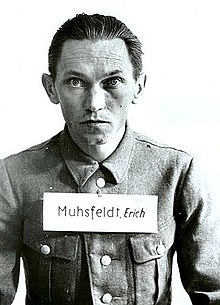Erich Muhsfeldt

SS-Oberscharführer Eric Muhsfeldt, also Eric Mußfeldt or Mussfeld (18 February 1913 – 28 January 1948) was a German non-commissioned SS-officer in two extermination camps in occupied Poland including SS-Sonderkommando at Auschwitz as well as at the Majdanek concentration camp during World War II. He was arrested, tried by the Supreme National Tribunal at the Auschwitz Trial of 1947 in Kraków, and sentenced to death for crimes against humanity. He was executed by hanging on 28 January 1948.[1]
Muhsfeldt was born on 18 February 1913. At the time of his service in the SS Totenkopfverbände he was reportedly married with one son. The fate of his wife is unclear. According to Miklós Nyiszli,[2] his wife was killed in an air raid and his son sent to the Russian front.
World War II atrocities
Originally Muhsfeldt served at Auschwitz I in 1940. He was transferred to the work/extermination camp at Majdanek on 15 November 1941. He was involved in the final mass shooting of the camp's remaining inmates known as the Operation Harvest Festival or "Erntefest". It was the largest single-day, single-camp massacre of the Holocaust,[3] totalling 43,000 in three nearby locations.[4] When the Majdanek camp was liquidated, he transferred back to Auschwitz, where he then served as supervising SS officer of the Jewish Sonderkommando in Crematorium II and III in Auschwitz II (Birkenau).
Upon his return to Auschwitz, Muhsfeldt, a committed mass murderer, had an unusual relationship with renowned Jewish-Hungarian pathologist Dr. Miklós Nyiszli, who was forced to carry out autopsies on behalf of Dr Josef Mengele.[2] Dr. Nyiszli survived the war and later gave evidence about what happened at Auschwitz. Dr Nyiszli described one incident when Muhsfeldt came to him for a routine check-up, after shooting 80 prisoners in the back of the head prior to their cremation. Dr. Nyiszli commented that Muhsfeldt's blood pressure was high, and inquired as to whether this could be related to the recent increase in 'traffic', as the mass murder of newly arrived victims was euphemistically called. Muhsfeldt replied angrily that it made no difference to him, whether he shot one person or eighty. If his blood pressure was too high, it was because he drank too much he said.[2]
After the war had ended Muhsfeldt was arrested, tried in Kraków by the Supreme National Tribunal in 1947, where he was sentenced to death. He was executed by hanging on 28 January 1948.
Notes
- ^ AHF (2013). "Auschwitz Trial (November-December 1947)". The Holocaust. Jewish Virtual Library.org. Retrieved 2013-04-23.
- ^ a b c Miklós Nyiszli (September 1, 2007; first published in 1946). "The Holocaust documents". Auschwitz: A Doctor's Eyewitness Account (a memoir). Arcade Publishing. Retrieved 2013-04-23.
Publication history and details at Goodreads.
{{cite web}}: Check date values in:|date=(help); External link in|quote= - ^ USHMM (May 11, 2012). "Soviet forces liberate Majdanek". Lublin/Majdanek: Chronology. United States Holocaust Memorial Museum, Washington, DC. Retrieved 2013-04-13.
- ^ Jennifer Rosenberg. "Aktion Erntefest". 20th Century History. About.com Education. Retrieved 2013-04-16.
